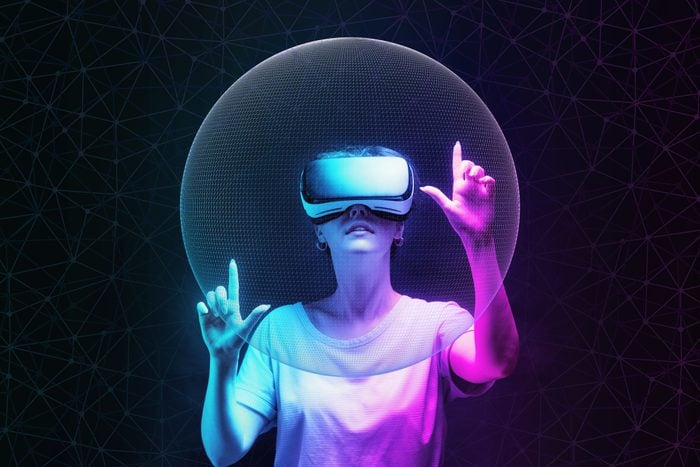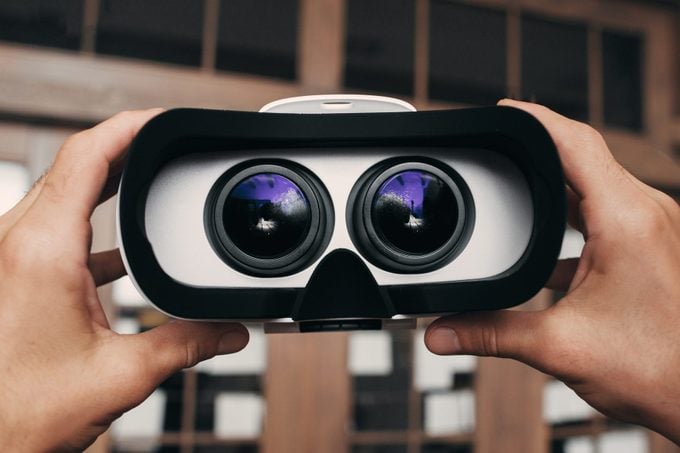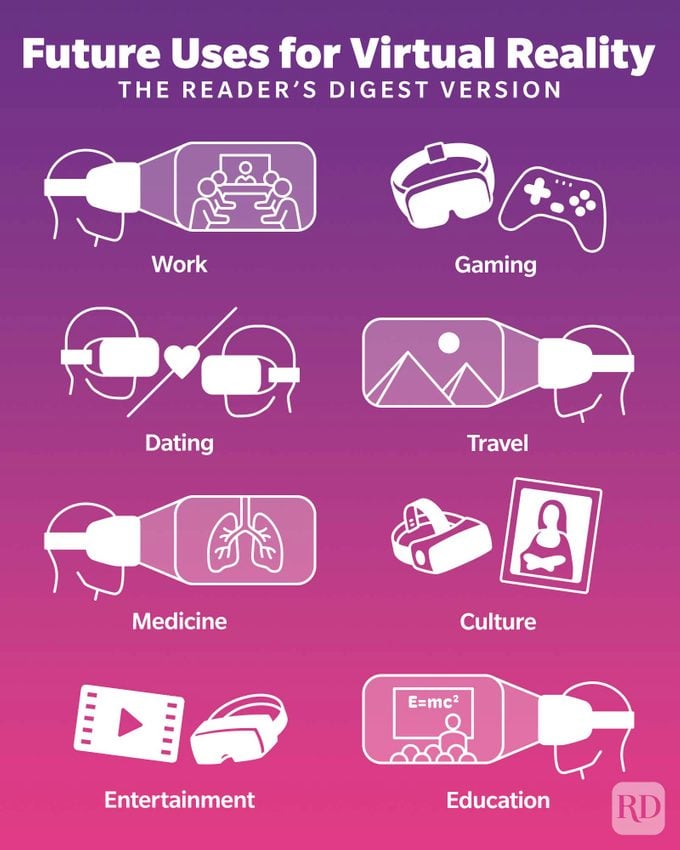What Is Virtual Reality, Exactly?
Updated: Feb. 14, 2023

Virtual reality has the potential to change our lives and shape the future
The Reader’s Digest Version:
|
Live in New York but want to attend your granddaughter’s birthday party in California—without leaving home? Meet her in another world to watch her blow out candles in real time. It’s not as crazy as it may sound. FaceTime and video chats have gotten us part of the way there, but they’re limited to screens. The next generation of social apps is taking people into a whole new dimension: virtual reality. And it promises to change the meaning of human connection. After all, what is virtual reality if not a way to connect people beyond the bounds of physical space?
Virtual worlds used to be the stuff of science fiction, but thanks to new technologies, these fantasies are quickly becoming reality. It won’t be long before you—or a simulation of you, rather—will be able to hit up that birthday party using one of the best VR headsets, says Chris Madsen, a senior engineer with Engage XR, a professional virtual reality and augmented reality platform used by many Fortune 500 companies.
If you’re still having trouble wrapping your head around futuristic ideas like robots, the metaverse and AR versus VR, you’re not alone. But don’t worry: We’re breaking down the concept and explaining the sort of tech you might encounter in the near or far future. So, what is virtual reality, exactly? Read on to find out.
What is VR?
Virtual reality uses computer technology to take you somewhere else—a digital “space” where you can move through and interact with others in a simulated environment. Whether that place is a cozy cabin, office building, golf course or sunny beach, the virtual world is getting more realistic and more functional, thanks to rapid advances in the technology, says Madsen.
But not all virtual reality is created equal. In the future, you might encounter one (or all) of four types: nonimmersive, semi-immersive, immersive and fully immersive.
Nonimmersive VR
You probably already use this type of virtual reality on a regular basis. These programs create a virtual place that you can look at and navigate using your phone or computer. First-person video games, home-decorating apps and all those virtual tours you can take right now for free fall under the nonimmersive virtual reality definition.
Semi-immersive VR
The next step up on the realism scale is semi-immersive VR. You use hardware, like a headset or a 3D screen, to make the virtual place seem like it’s around you. You can explore the virtual place, but you’re still interacting with it using things in the real world. Examples include flight simulators and 3D rides at amusement parks.
Immersive VR
Virtual reality that uses a headset, hand controls, motion detectors and possibly other wearables to give you the full otherworldly experience is considered immersive VR. You can physically walk around a virtual place while interacting with it inside the VR world. For instance, you can walk into a shoe store, pick a shoe from a shelf, check it out and then purchase it—all from your living room.
Fully Immersive VR
Tech that stimulates all five senses to give a “real” virtual experience is called fully immersive VR. You’ve probably seen something like it in sci-fi movies. And while it’s not quite a reality yet, the technology is coming faster than you may think. In fact, Madsen estimates it’ll likely be available to the public within the next few years.
What are AR, MR and XR?
If the idea of a virtual world is blowing your mind, then there’s a good chance you’re curious about other ways the technology might change our lives in the future. And that’s where AR, MR and XR come in.
Take AR, or augmented reality, a tech that’s sort of like virtual reality’s cousin. Identifying augmented reality vs. virtual reality isn’t hard. Think of it this way: With VR, you’re going to a virtual world away from the real world. AR, on the other hand, augments your reality.
In other words, AR brings the virtual world into your real world. If you’ve ever used a Snapchat face filter or a stargazing app that highlights the constellations in your view when held up to the sky, you’ve experienced augmented reality. Probably the most famous example of AR, though, is the Pokémon Go game, which superimposes images over reality.
If VR exists in a virtual world and AR adds virtual elements to the real world, then it should make sense that MR, or mixed reality, blends aspects of both. Microsoft, for instance, has created its HoloLens as a mixed reality device that uses a see-through display to combine the virtual and real environments.
XR, or extended reality, is the umbrella term for any tech—including VR, AR and MR—that creates a virtual component of the real world.
How does VR work?

Though it sounds like something from the future, virtual reality has been around for decades, and it still works similarly, though the quality has certainly improved.
When was VR invented? The first virtual reality prototype was created in 1968 by American computer scientist Ivan Sutherland and his student Bob Sproull. The device was clunky—its weight earned it the name Sword of Damocles—and primitive by today’s standards, but it was groundbreaking in that it generated a virtual world with realistic images.
Thanks in part to artificial intelligence, the tech has come a long way in the past five decades. Today, virtual reality requires two main components: wearables that give environmental information to the computer and virtual information to you, plus programs, computer software and firmware that put it all together in a hyperrealistic way, says Madsen.
Vision is the primary way human brains get information about the world, so the accurate simulation of sight is the primary focus of most VR. Computers use sophisticated software algorithms to make two-dimensional images and videos feel three-dimensional. Once these images and videos are rendered, or processed and put together, they are sent to a screen in the VR goggles or headset.
The screen serves two purposes: It blocks out information from the real world, shielding your field of vision from the light and objects in your physical space. And it displays the virtual world. Two autofocus lenses sit between the eyes and the screen and adjust automatically based on your eye movement and position, allowing the computer to track and adjust the VR display to be congruent with what you’re doing in real life.
Similarly, algorithms create stereo sound that is then projected, in sync with the images, to the headset. Motion and pressure sensors in the headset and hand controls give feedback to the computer, which then changes the 3D environment based on your physical actions. Newer technology is working on making VR gloves and other tech to virtually simulate every sense—including touch, smell and even taste.
Wearable devices
Sci-fi movies might feature brain implants that let people access the virtual world with a thought, but that’s not our reality (at least not yet). To enter a virtual space, you’ll need a few devices aimed at engaging your senses to make the virtual world feel real. They include input devices (tech that gives the computer information from you) and output devices (the way the virtual reality is displayed to you).
- Headsets: The most important piece of equipment is a headset that covers your eyes and visually blocks you from experiencing reality. This is what makes the virtual world so immersive. Headsets range from low-end cardboard devices that you insert your phone into to powerful high-end devices with screens better than most televisions.
- Headphones: These provide stereo sound and are often built into the headset. Audio feedback is part of the reason virtual reality can feel so real.
- Mounted cameras: Cameras on the outside of the headset give the computer feedback about your real environment so it can adjust the virtual one.
- Trackers: Some VR devices now include components that can track your motion, eye movement and facial expressions to better tailor the virtual world to you.
- Controllers: To interact with virtual objects you’ll need handheld controllers or wired gloves. With these wearables, you’re engaging yet another sense—and the more senses involved in the experience, the more real it’ll feel.
- Sensors: These aren’t super common (yet!), but the technology exists to sense things like temperature, smell, taste, humidity and proximity. Further in the future, VR wearables will make you feel the warmth of the sun when you’re visiting a virtual beach. They’ll help you smell the sea breeze and taste the tang of a lemonade—all while you’re in your living room.
Software
VR software has a big job: It’s in charge of delivering the VR content from the cloud and the internet and managing all that content. And it needs to manage all connected devices, analyzing incoming data from the user and environmental sensors and then generating the appropriate display. The trick is to do it accurately, quickly and realistically. The better the software manages this, the more realistic the experience. (VR software that fails at these three things is what makes people get dizzy or nauseous.)
Most VR software is based on a “virtual world generator,” which is made using a software development kit from a specific VR headset vendor. This kit provides the basic programs, drivers, data and graphic-rendering libraries.
Different companies have their own proprietary devices, virtual world kits, VR programs and games, which accounts for the differences in quality and experiences among the different platforms. Major players include Meta (formerly Facebook), Oculus (now owned by Meta), Sony, HTC, Pico, Valve and Samsung.
What can you do with VR?
Historically speaking, gaming has been the most popular use of VR, and that’s still the case—the VR gaming market is expected to hit $92 billion in 2027. But as more industries embrace the technology, they’re finding new and innovative ways to use it, says Madsen.

Take, for instance, the real estate sector. Sotheby’s International Realty has started offering tours of high-end homes in virtual reality, letting prospective homebuyers skip the hassle of in-person viewings. (This type of VR for real estate is, of course, not the same thing as the virtual real estate you can own in the metaverse.)
So, what is virtual reality good for beyond those applications? Whether now or sometime in the future, you might head into a virtual world for:
- Gaming
- Job training
- Managing pain
- Learning in virtual classes
- Taking part in work meetings
- Having medical appointments, including therapy
- Team building
- Traveling, and not just on earth (but for now, you can make do with the best virtual space exhibits)
- Socializing
- Dating
- Shopping
- Exploring museums and historical events
“Recently, I ‘went’ to a virtual networking event that was on a luxury yacht moored at a tropical island,” Madsen says. “It was so much more fun and relaxing than a Zoom meeting.”
With the future of AI promising to revolutionize everything from health care and manufacturing to our work lives, the potential for virtual reality advances is great. What is virtual reality going to look like years in the future? Well, someday education may happen in virtual space, essentially dropping students into the action with visuals that rival reality. Just imagine: Students pop on their headsets, cue up the virtual world and experience the Gettysburg Address from a hyperrealistic Abraham Lincoln.
Pros and cons of VR
The benefits of virtual reality are many. Doing things virtually reduces expenses, risks and time—one reason office workers want to make sure work is one of the things that stay virtual forever. Plus, VR adds features that don’t exist in the real world and that can improve lives in a bunch of ways.
Imagine medical students learning anatomy by “walking through” a giant virtual human body. Not only could they zoom in or out to better visualize organs, tendons and other parts of the body, but they could also pull up additional information by touching different body parts. They could practice sutures or even surgery on a virtual patient before testing their skills on a live person.
The benefits for people with injuries and disabilities are great. Virtual reality could open a world of exploration for people who are unable to travel but can use VR to experience global adventures. Beyond that, virtual reality has a powerful effect on the brain’s behavior. For instance, one small study found that burn victims who used virtual reality to “visit” a snowy mountain felt pain relief similar to prescription narcotics.
There are some real physical and mental drawbacks, however, says Madsen. There’s the obvious risk of physically injuring yourself from tripping or falling while wearing a headset that changes what you see. But people are also reporting headaches, vertigo, muscle soreness and vision issues after experiencing VR. These stem from both the physical components and the way the brain perceives artificial reality. Thankfully, they’re becoming less of an issue as the technology becomes better, he says.
The more subtle risks are mental. Because VR provides a much more realistic experience than watching something on a computer screen, the emotional and mental impacts are more intense. Watching a horror movie in VR, say, could cause real trauma, according to Madsen. Then there’s the fact that all the downsides of the internet—privacy and data collection, violent pornography, the black market, sex trafficking and criminal activities—are magnified in VR.
Will VR replace the internet?
When you think of virtual reality, your mind might jump to a future in which the virtual world is our internet. But experts see our digital future in a slightly different way.
For starters, all types of extended reality exist in the metaverse, the “universe” of the virtual world. It’s founded on the internet and isn’t owned by a single country or corporation. It’s possible to bring up web pages or apps within virtual environments, but VR goes far beyond what the internet can do, says Madsen. Virtual reality isn’t replacing the internet; it’s expanding and building on it.
Think of it this way: With the internet as we know it today, you can open YouTube and find a 3D virtual tour of the International Space Station. Pretty cool. But in the future, space tourism won’t just be a reality; it’ll be a virtual reality too, which means you could potentially enter the metaverse and walk around the space station (or a planet!) as if you were there.
When it comes to the virtual world, the possibilities are endless, though they’re a ways off. “Remember when the internet first exploded in the ’90s? That’s where we are with virtual reality now, and like the internet did, it’s going to revolutionize everything,” he says. “Soon it will be as simple as putting on a pair of sunglasses and as automatic as pulling out a smartphone.”
Sources:
- Chris Madsen, senior engineer for Engage XR
- Expert Review of Neurotherapeutics: “Applications of virtual reality for pain management in burn-injured patients”
- Frontiers in Virtual Reality: “The Combination of Artificial Intelligence and Extended Reality: A Systematic Review”
- International Journal of Scientific & Engineering Research: “Brief Introduction of Virtual Reality & Its Challenges”
- MIT: “Center for Advanced Virtuality”
- Grand View Research: “Virtual Reality in Gaming Market Size Worth $92.31 Billion by 2027”



